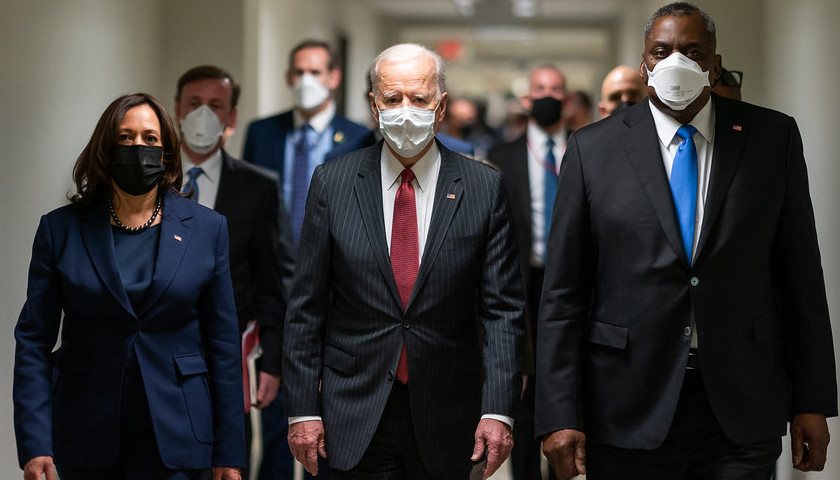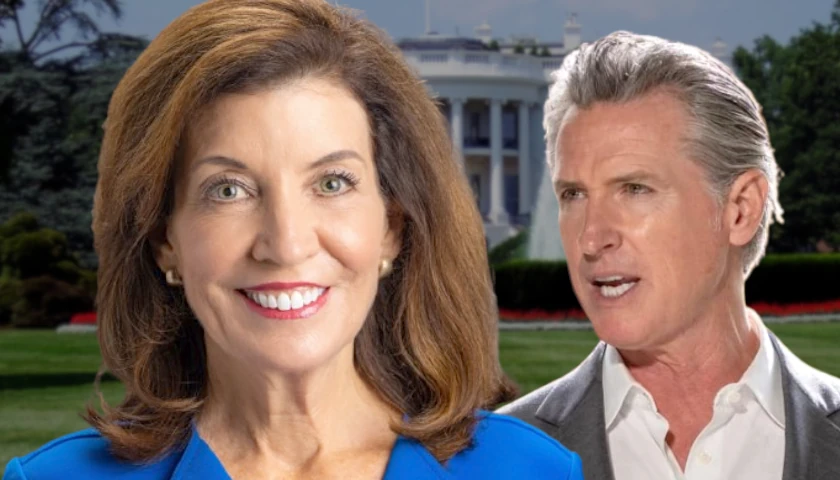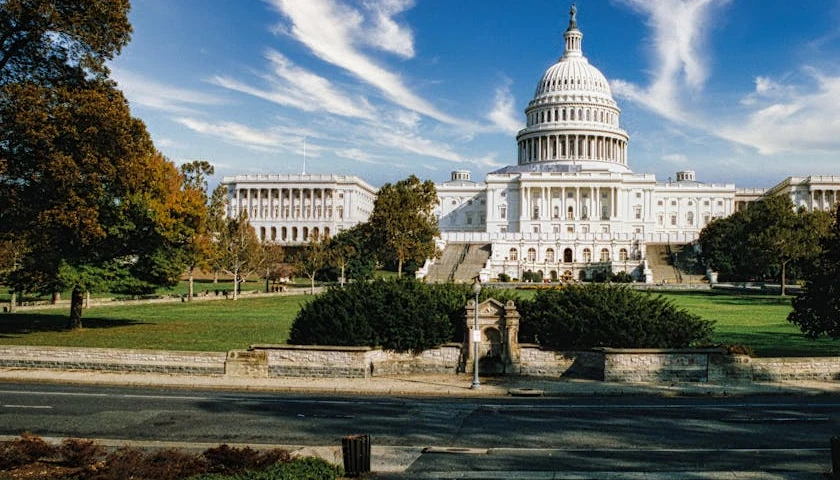by Ruth Papazian
Mainstream voters in both parties feel that neither major party represents them, and that their opinions and wishes hold little sway over government policy.
Establishment Republicans failed the average American by becoming captive to extreme Libertarian ideology that is divorced from the reality of most people’s lives.
Establishment Democrats failed the average American by becoming captive to extreme Social Justice ideology that is divorced from the reality of most people’s lives.
Rather than two oppositional parties that hold each other accountable, we have a Uniparty aligned with the administrative state to maintain a status quo that lets the good times roll . . . for the swamp. This status quo is inexorably pushing increasingly marginalized voters to a second civil war.
Regardless of party affiliation, most Americans are centrist or somewhat right of center, yet the administrative statekeeps pushing the status quo ever to the Left, because Congress largely has ceded its legislative powers to unelected career bureaucrats who promulgate the rules and regulations that implement laws.
Neither party saw Donald Trump coming. Neither party saw Bernie Sanders coming. And the establishment wings of both parties are scared to death of an unpredictable and escalating populist backlash that spans the political spectrum, stoked by their decades of ruinous policies, and their cozy relationships with Wall Street, tech oligarchs, and big money donors.
Could An America First Populist Party Be Viable?
In the fraught and tumultuous weeks following the November election, various polls suggested that three-quarters of Republicans and a third of Independents don’t trust/are unsure about the election results (page 43 of a Marist poll taken in early December). These voters believe there was a well-planned, co-ordinated effort to pre-determine the results of the election.
When courts threw out dozens of lawsuits brought by individual voters, states and the president himself, tens of millions of Trump voters felt disenfranchised and marginalized. They didn’t just lose a president, they lost his America First populist policies that created a strong economy, resurgence of blue collar jobs, historic low levels of unemployment, middle class tax cuts and the highest median household income ever recorded. Oh, and peace breaking out all over the Middle East.
In response to both the questionable election and the anemic Republican response to obvious liberal skullduggery, Trump supporters on social media began to rally around the idea that the Republican Party “needs to go the way of the Whigs”—by which they mean leaving the party and/or launching an America First populist third party to continue Trump’s populist policies that the Republican establishment had never supported.
How big might this third party be? Consider these stats:
- A mid-January 2021 Gallup poll found that 30 percent of Americans identified as Democrat; 24 percent as Republican, and 45 percent as Independent. Among the Independents, when asked whether they leaned toward one party or the other, 51 percent self-identified as Democrats or leaning Democrat, and 37 percent as either Republicans or leaning Republican.
- At the end of January, a Hill-HarrisX poll found that 64 percent of registered Republican voters said they’d join a new political party led by Trump, with 32 percent indicating they would “very likely join.” Moreover, 28 percent of Independents and 15 percent of Democrats said they’d likely join a third party led by the former president. Overall, 37 percent of voters said that they’d likely join such a new political party.
- A poll of 1,200 registered voters was conducted by Scott Rasmussen during the same time period. Asked which party they would choose in 2024 should Trump were to form a “Patriot Party,” 46 percent would choose the Democratic Party; 23 percent would switch to the new party, 17 percent would stay with the GOP; and 14 percent would choose another (presumably) third party.
- A CBS News poll of 2,508 U.S. residents interviewed in early February found that 33 percent of Republicans would join a Trump-led new party, and another 37 percent might join.
- A new Gallup poll finds that interest in a third party has reached an all-time high (62 percent of a random sample of 906 adults across the nation), with respondents agreeing that “[The Democratic and Republican] parties do such a poor job representing the American people that a third party is needed.”
If between 23 percent and 37 percent of the electorate makes good on the intention to join an America First populist party, it would rival or eclipse the Republican Party in size right from the jump. And with #NeverTrumpers also leaving the party and threatening to form their own third party, the GOP could, indeed, go the way of the Whigs.
But Wait … There’s More
Trump and/or a populist party may also have support from two surprising sources: Green Party and Bernie Sanders voters.
There has been a strong anti-establishment populist strain in this country going back to its very beginnings—some would argue that the Revolutionary War was the culmination of the first American populist movement. Sometimes a populist movement is leftist (Occupy Wall Street), sometimes it tilts right (Tea Party). Regardless, a Venn diagram of the hot-button issues for populists across the political spectrum shows a lot of overlap.
Though Hillary Clinton slurred 2016 Green Party presidential nominee Jill Stein as a Russian ringer put into the race to take votes away from her, the majority ofGreen Party voters were #NeverHillary. Exit polling in the 2016 presidential race found that 61 percent of Green Party voters would have sat out the election if Stein had not been on the ballot and 14 percent would have voted for Donald Trump.
And nearly one out of eight Sanders supporters (12.5 percent)—some of whom gravitated to the Green Party after their candidate was cheated out of the Democratic Party nomination in 2016—voted for Trump in states where he and Hillary were neck-and-neck. This was no fluke: In the 2020 election, a March 2020 ABC News/Washington Post poll found that15 percent of Sanders-supporting Democrats said they would swing to Trump instead of to Joe Biden in the general election.
Why did some Green Party and Sanders voters prefer Trump over Clinton? In part because there wasa surprising number of shared policies and positions between the progressive Stein and the populist Trump, including: Prosecuting Hillary over her use of a private email server when she served as Secretary of State; exporting jobs to other countries, rigged trade agreements and Wall Street deregulation conspired to drive down employment opportunities and wages for American workers; NAFTA and TPP are disasters; Wall Street should not have been bailed out; America shouldn’t be getting into wars with other countries when our national security is not directly threatened; regime change is a bad idea—especially as regards toppling Syria’s Assad; we should get out of Afghanistan; we need better relations with Russia; North Korea should be denuclearized; and Medicare should be able to negotiate pharmaceutical prices for beneficiaries.
There was little overlap between the issues important to Green Party and Sanders voters and those Hillary Clinton ran on—inasmuch as she was able to articulate a rationale for her campaign other than it was “her turn.”
Promising polls and stats notwithstanding, third parties face many hurdles, among them qualifying for taxpayer funding during the primary and general election, and qualifying for automatic ballot access. A political party must receive at least five percent of the vote in the previous presidential election to qualify for federal funding, and to be placed on the ballots of every state and Washington, D.C. without having to navigate complex, labor-intensive ballot access laws that differ from state to state.
Though there were reports that Trump wanted to launch and lead a populist third party, these were likely among the reasons he distanced himself from the idea and disavowed any connection with a group that launched a political committee called the MAGA Patriot Party.
Hijacking the Republican Party Only Gets You So Far
Clearly, third parties are doomed to failure whereas commandeering an existing national party is the only path to success—as Trump himself demonstrated in 2016.
While some believe the Tea Party hijacked the Republican Party, this is not the case. The Uniparty establishment viewed the Tea Party as a threat to the status quo and moved to squelch it.
Democrats in both chambers of Congress unleashed the IRS on Tea Party groups, while the Obama Administration used the machinery of the federal government against its leaders—ATF, FBI, OSHA, EPA—to ruin them financially (sound familiar?).
Meanwhile, the Republican Party used something like a political “catch and kill” strategy by co-opting the Tea Party movement and suppressing its populist message while promoting divisive social wedge issues like abortion and gay marriage that Tea Party leaders had purposefully avoided. Still, Tea Party populism survived among a significant percentage of the Republican base, who found a populist champion in one Donald J. Trump.
Sizing up the field of 16 candidates the late conservative commentator Charles Krauthammer declared “the strongest field of Republican candidates in thirty-five years,” Trump mowed them down bing!, bing!, bing! with a devastatingly skillful application of Alinsky’s Rules for Radicals to become the party’s nominee and the 45th president of the United States against seemingly insurmountable odds and a concerted effort by members of the Obama Administration to derail his candidacy.
But early in Trump’s tenure, it became clear that winning the White House didn’t guarantee the support of the Republican Party establishment in Washington, D.C.. Quite the opposite: In 2017 and 2018 when Republicans held both chambers of Congress, House Speaker Paul Ryan and Senate Majority Leader Mitch McConnell undermined the president, and failed to deliver on his key campaign promises—most notably, denying funding to build the wall along the U.S.-Mexico border; failing to “repeal and replace” Obamacare; and the letting the “Justice for Victims of Sanctuary Cities Act of 2019” languish in the Senate Judiciary Committee. The GOPe worked as hard to impede Trump’s policies as the Democrats’ Resistance and the permanent bureaucracy.
All along, the GOP establishment had been waiting out Trump and his America First populist policies. Losing the House in the 2018 midterm election guaranteed that the uniparty status quo eventually would be restored because Trump was forced to rely on Executive Orders throughout his presidency to push his policies forward. Now that Trump is no longer in office and Biden is undoing in a matter of days what took four years for Trump to accomplish, it is obvious that hijacking the Republican Party was a short-term strategy that did not accomplish a lasting realignment of American politics.
Go Big Or Go Home
Nine out of ten rank-and-file Republican voters and several voting blocs that don’t typically vote Republican (including Latinos, blacks, Native Americans, Native Hawaiians and union voters) support Trump’s policies—which means, in theory, America First populism is bigger than Trump, and can continue to grow with or without him.
Trump’s base refuses to return to a status quo that enriches Washington elites at the expense of the working and middle class. But a third party can’t succeed, and the swamp proved more formidable than even the indomitable Trump. So how can America First populist policies find a political home?
To get around the substantial obstacles that hamper the success of a third party, Matt Welch suggests America First populists “merge” with an existing party. After running through the pros and cons—mostly cons—of more than half a dozen third/fringe parties, he suggests that Trump supporters and/or America First populists target the Constitution Party for a friendly takeover.
The hard Left is also trying to effect its own political realignment. Writing in The Nation in December, Jonathan Smucker, author of Hegemony How-To: A Roadmap for Radicals, recommends “an inside-outside approach to electoral politics” in which the Democratic Party is “contestable terrain.” In other words, hijacking and permanently transforming the Democratic Party to a far-Left radical party instead of forming a third party.
Given the choice between hijacking an obscure third party to create another third party vs. hijacking the Democratic Party, Smucker’s audacious strategy is more likely to succeed in the long run for America First populists. And remaking the Democratic Party into an America First populist party solves several seemingly intractable political problems:
- The Democratic Party would be deradicalized, and more aligned with mainstream voters.
Though they are currently in the political minority in the party, radical social justice Democrats relentlessly and viciously enforce ideological hegemony with asymmetrical warfare tactics that include public shaming, online “doxxing” and “cancelling” people for perceived thought crimes using acquiescent social media platforms as a force multiplier. The political price for enraging the social media mob is too high for most elected officials in both parties.
Consequently, the Democratic Party establishment bends over backwards to appease the most radical members in their ranks—at the expense of the mainstream moderates—in the hopes that they can avoid being eaten alive by the Woke Alligator. For their part, the Republican Party establishment routinely throws up the flag of surrender instead of fighting for the principles they run on and claim to hold.
Should America First populists who are now divided among the Republican, Independent, Conservative and Democratic parties unite together in the Democratic Party en masse, they would immediately outnumber the Social Justice Democrats and negate their outsized influence over the party.
With Social Justice Democrats suddenly sidelined in the Democratic Party, establishment politicians like Sen. Chuck Schumer (D-N.Y.) and House Speaker Nancy Pelosi (D-Calif.) would very quickly tack to the center. There would be no more talk of packing the Supreme Court or adding new states.
- The waning influence of social justice Democrats would make it impossible for them to hijack the Democratic Party and to keep electing radical candidates to local, state and federal office.
Colleges and universities are pumping out new social justice warriors and anarchists by the thousands every year. Their eventual takeover of the Democratic Party is facilitated by the outflow of center-Right Reagan Democrats some 40 years ago; the exit of Brandon Stratka’s WalkAway Democrats now; and elderly traditional Democrats dying off.
Mainstream Democrats are bewildered and frightened at how quickly they are becoming as marginalized in their own party as Republicans are in deep blue states like New York.
If Reagan Democrats return to the party (as I did several weeks ago), and America First populists currently registered as Republicans, Independents, and Conservatives switch parties, they would offset the steadily increasing numbers of social justice Democrats and the waning numbers of traditional Democrats. The energy and enthusiasm in the party would shift from the radicals to the populists, which facilitates electing mainstream and populist Democrats (some of whom will be ex-Republicans) in deep blue districts/cities/states with closed primaries GOPe gave up trying to win years ago.
- If social justice Democrats are unable to advance radical candidates past the primary and into office, they could leave the Democratic Party.
Having failed to hijack the Democratic Party, social justice Democrats would likely join the Democratic Socialist Party of America (DSA)—which would complete the deradicalization of the Democratic Party. With the America First populist Republicans and Republican-leaning Independents having moved to the Democratic Party, the DSA may well be larger than the remnants of the GOP—but will be smaller and weaker than the GOP is in blue states now. Nonetheless, unlike the GOP, the DSA will be a true oppositional party to a populist Democratic Party.
A populist party and a socialist party will have starkly different policies and visions for America, and are extremely unlikely to morph into a uniparty. Voters will have a clear choice at the polls.
Gotta Do What You Gotta Do
In a February 2012 New York Times interview, Jill Stein observed that the Democratic and Republican parties are both sinking ships; one just sinks faster. With Trumplican and Trumocrat America First populists uniting in the Democratic Party, both parties as currently constituted will sink even faster, but sink simultaneously. And the political realignment that serves the interests of the vast majority of American voters can finally occur.
As a rule, voters rarely switch parties but in the post-Trump era it will become a necessity. And it’s not just Republican populists who will have to join the Democratic Party, but Independent voters who liked Trump’s policies.
In closed primary blue states where the Republican Party is weak, being able to defeat social justice candidates in the Democratic primary is the only way to begin to deradicalize the party. And in blue and purple states with partially closed, partially open, or open primaries, having the strength in numbers to field and elect populist Democrats will keep the America First populism movement going.
Trumpocrats chose Trump over Hillary in 2016 and/or Trump over Biden in 2020. The Trumpocrat movement actually predates the WalkAway movement by two years. The difference between the two movements that targeted Democrats is that the Trumpocrats stayed in the party, whereas the WalkAways switched to the Republican Party.
And now, there is a growing movement to encourage Republicans in New York City to switch parties to vote against radical Democrats in the primary—particularly in this year’s crucial mayoral race.
Lisa Blau, founder of the Be Counted NYC independent expenditure committee (IEC), told Politico that moderating the Democratic Party with Republican voters will encourage voter participation—which was a shockingly low three percent in the 2013 Democratic primary that put Bill De Blasio into office. And those New Yorkers who cast votes in the primary were likely “more ideologically extreme and partisan than the electorate as a whole.”
The New York Times recently reported that Equinox chairman Stephen Ross, a Trump bundler, donated $1 million this month to a different IEC, Common Sense NYC, which is also focused on electing moderate candidates in New York City with the help of Republican voters who switch parties.
Pragmatic Republican voters understand the strategy, but those too blinded by partisanship are in denial about how feeble the GOP is in New York City and the futility of expecting the party to prevent the election of increasingly radical candidates to local, state, and federal office.
One friend who gets it says, “I am a registered Democrat in New York City. We don’t have Republican primaries, so what’s the use? I’d rather use my voting power to vote against self-avowed socialists and for a moderate Democrat.”
Another friend who lives in D.C., where “the Democrat primaries are de facto general elections” says, “Republicans here register as Democrats because it’s the only way they have any say in elections.” She adds that not enough of them have switched parties yet “to really make a difference.”
Is Populism Stronger Than Partisanship?
According to local news station NY1, “So far this year, more than 2,400 Republican voters and more than 4,700 voters have switched their party registration to Democrat, according to the New York City Board of Elections.” It’s a start, but these numbers are unlikely to influence the outcome of the Democratic primary in the 2021 mayoral race.
And were a moderate to win election, he or she needs an accommodating City Council. Because of term limits, this year 35 of 51 City Council seats will be contested in the Democratic primary, and DSA is vying to win up to six of them. “Many rank-and-file Democrats abhor the DSA’s platform,” as Crain’s New York Business correctly notes. It’s a crying shame there won’t be enough Republican voters switching parties in time to stop DSA candidates from advancing past the Democratic primary in June.
Why are Republicans and Republican-leaning Independents seemingly resistant to the obviously logical strategy of infiltrating the Democratic Party in large enough numbers to affect the outcome of elections? Most cannot stomach the idea of joining a party that fights in lockstep to promote repugnant policies like day-of-birth abortion, unwise policies like defunding the police, and malicious policies like keeping states locked down while stalling COVID relief for political gain in a presidential election year.
In the CBS News poll cited above, 57 percent of Republicans described Democrats as “enemies,” and believed that their “life or entire way of life may be threatened” if they win. But by hijacking the Democratic Party, America First populists will fundamentally change the party and its policies from the inside—which GOPe has utterly failed to do from the outside.
For this reason, tactical voting is morally defensible—and failing to use one’s vote as effectively as possible by switching parties means perpetuating depraved and perverse policies. For Republicans and Republican-leaning Independents to refuse to change parties, therefore, is cowardly and immoral.
Joe Biden campaigned on unity, and in his inaugural address he droned, “[M]y whole soul is in this: bringing America together, uninin [sic] our people, uninin [sic] our nation. And I ask every American to join me in this cause.” America First populists currently siloed in several parties should give Biden the unity he wants good and hard by moving into the Democratic Party and voting en bloc.
The faster America First populists hijack the Democratic Party, the faster moderate and populist Democrats will be encouraged to run for office. And the more of them who are elected, the more deradicalized and populist the Democratic Party becomes. When the takeover is complete, the Democratic Party can be renamed the Unity Party or the United Populist Party.
– – –
Ruth Papazian is a Bronx-based health and medical writer, and a political junkie.





